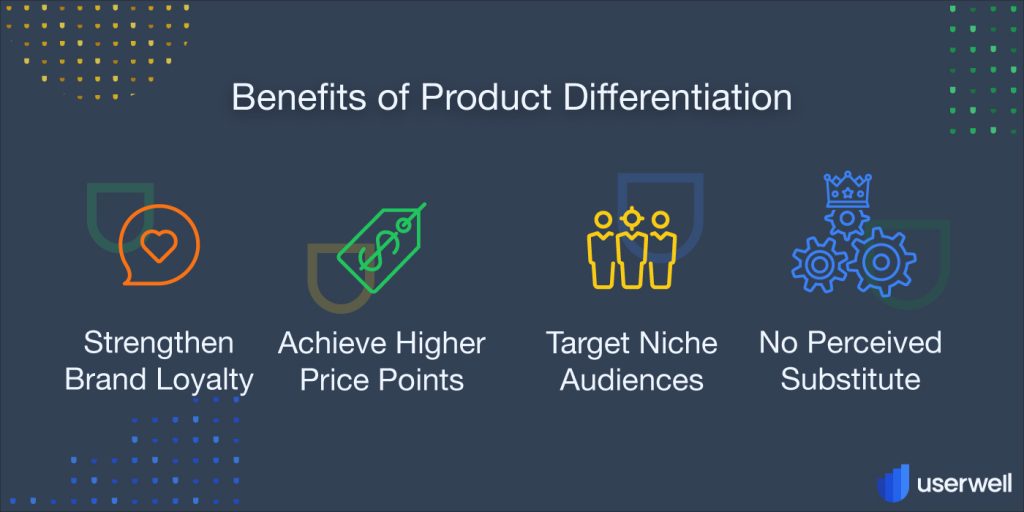Product Differentiation
Product differentiation is a marketing strategy that distinguishes a product or service from others to make it more desirable to target audiences.

Today’s markets are heavily oversaturated and overcrowded. Product differentiation, or setting your product apart from other similar products, is therefore imperative to your business’s success.
By highlighting your product’s unique aspects, you make your product appear more attractive and valuable. And the more people perceive it as valuable, the more they’re willing to spend for it. That gives you a competitive advantage and a potentially greater market share.
This strategy of increasing a product’s value through its unique qualities is called product differentiation. In this glossary article, we define product differentiation and how you can employ it to become your customer’s top choice.
Table of contents
What is Product Differentiation?
Product differentiation increases the perceived value of a product or service by highlighting the one or many qualities that make it different from all other similar products or services in the market. Differentiation can range from having more features or a better customer experience to a lower price (or a combination of these).
Because product differentiation hinges on how your consumers perceive product value, you don’t always need to focus on specific features. Instead, you can emphasize its packaging, promotional quality, or its name. Muji, for example, differentiates its products by promoting a minimalist lifestyle, even if they’re selling general stationery products.
The key to a successful product differentiation strategy is to research and understand your buyer persona and your competition. This way, you’ll know how to best emphasize your product benefits and features.
Types of Product Differentiation
The purpose of product differentiation is to influence your consumers’ buying decisions so that they choose you over everyone else. Each market has different customer behaviors and preferences, and this influences how differentiation is used. There are three main types of product differentiation based on these market variances.
1. Vertical Differentiation
Vertical differentiation is when consumers use objective qualities to compare products and choose the one that ranks highest. Buyers often select products based on having one decisive feature or multiple valuable features.
Although the qualities for ranking are objective, different consumers look for different qualities, so what will make them choose one product over another is highly subjective. For example, a graphic designer will pay attention to the RAM, memory capacity, and screen resolution when buying a laptop. On the other hand, a writer might focus more on the laptop’s weight and keyboard functions.
2. Horizontal Differentiation
Horizontal differentiation is when customers choose based on personal preferences, such as colors and flavors. Because these metrics are subjective, there are no truly better or worse options on the market.
Because of this, businesses can price their products freely even if the actual cost of making them differs. One instance is when Hawaiian and pepperoni pizzas have the same prices, even if it costs less to produce the latter. This is because Hawaiian products use seasonal ingredients.
3. Mixed Differentiation
Mixed differentiation occurs when a consumer buys based on both horizontal and vertical differentiation. For example, buyers of running shoes often consider vertical differentiation, selecting products based on price, size, and flexibility. They may also simultaneously decide on a product based on style and color, demonstrating horizontal differentiation.
More often than not, mixed differentiation is what drives purchasing decisions, because people have varying definitions of what’s best for their needs.
What are the Benefits of Product Differentiation?
Although there are many other advantages to product differentiation, here are the top ones that will help drive your company to success.

1. Strengthen Brand Loyalty
Differentiation allows you to foster customer trust by proving that you can better solve their problems and improve their lives over your competition. Once you’ve established that trust through one product, consumers often extend it towards your entire brand and all the products and services under it.
Apple is one brand that succeeded in doing this. When Apple started, Windows-based machines dominated the industry without much competition. However, by demonstrating that Macs were completely unique in the market, Apple was able to build a loyal consumer base. Eventually, they evolved to become a market leader whose products are highly regarded by their customers.
In fact, Apple’s customers are so loyal that when they first released the iPhone, no one questioned why a computer company was dabbling in cell phone production. Instead, customers already believed that it carried the same quality and innovativeness that Apple’s computers have.
2. Achieve Higher Price Points
Differentiation increases perceived value through customer service, packaging, added specifications, durability, and design. Because of this, consumers believe that you’re better than the competition, and may be willing to pay more for your product and services.
Product differentiation can also create a sense of urgency, which allows you to place a higher price tag on the products you sell. One such example is when Adidas created a limited edition pair of sneakers in partnership with Kanye West. While regular sneakers were priced at $70, the limited edition version was sold at $315.
3. Target Niche Audiences
Because differentiation focuses on distinguishing products, you can more effectively target niche markets based on their interests and desires. For example, Samsung releases various iterations of their phones to target consumers with different economic backgrounds:
- The Galaxy and Note series targets consumers who have higher budgets when it comes to mobile phones
- The “A series” presents a more affordable option for customers who have smaller budgets
- The discontinued “J series” that was their entry line of cell phones
4. No Perceived Substitute
By emphasizing quality in your product differentiation strategy, you build the idea that your product is irreplaceable, even when other products in the market provide similar features.
Apple again is a great example in this regard. They’re able to maintain the image that their phones, music players, and computers have uniquely superior features. Their consumers often avoid trying other brands in the belief that these brands lack the quality of Apple products.
Unlocking Your Unique Potential Through Product Differentiation
Product differentiation is a needed strategy in modern-day markets where competition is fierce and diverse.
In fact, you may no longer just be competing with local businesses, but with international companies as well. With differentiation, you distinguish your product in a sea of thousands, increasing its market reach and perceived value. This helps brands to foster customer loyalty, target niche audiences, and boost profits.
